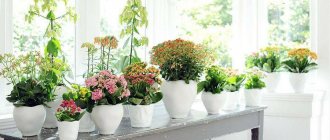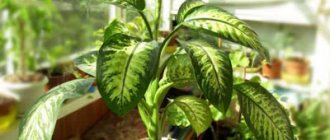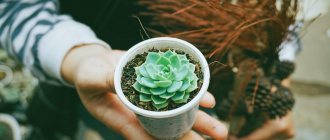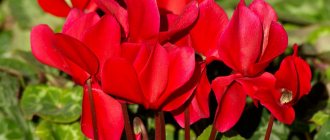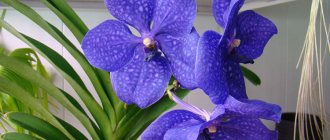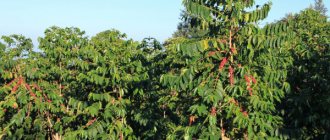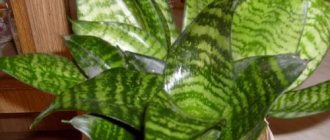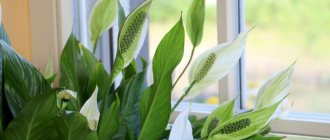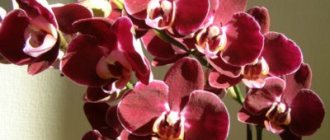/Accessories and decor/Gardening/
Schefflera (or shefflera, as they often look for it in search engines, having lost the second “f”) is a beautiful and literally friendly plant: its unusual leaves resemble a palm that you just want to shake. Somewhere in the world another unofficial name has taken root - “umbrella” or (even cuter) “gnome’s umbrella”.
Although you can’t expect schefflera to bloom in an apartment, the bright foliage of a neat bush itself greatly decorates the space. Moreover, the flowering of Schefflera is very inconspicuous, and the berries that may form are completely poisonous. They can be safely removed when formed.
The best qualities of shefflers:
- To the delight of all tea gardeners, caring for shefflera at home is elementary;
- You can form a fancy stem by planting several young plants while they are flexible;
- If all conditions are met, you can grow a fairly tall (up to one and a half meters) and lush tree. This is how a potted plant has a chance to become an outdoor plant;
- Often the plant is placed in rooms where tobacco smoke penetrates. It is believed that shefflera firmly takes the blow: it neutralizes resins and ozonizes the air;
- A certain type of Schefflera is suitable for practicing the art of bonsai.
For mini-tree lovers, this is a must have!
Important: the juice of schefflera leaves can cause irritation, so prevent children from botanical experiments and cats’ pranks.
Lighting
Schefflera is moderately demanding of good lighting and will happily extend its palm-shaped leaves to the light. The ideal window is southern, acceptable are western and eastern.
Advice: if you want to have this plant, but the room is annoyingly dark, or the pot will be located not on the window, but in the back of the room, choose green rather than variegated types of schefflera. Variegated Schefflera have higher light requirements than regular green ones.
In the summer, the plant will be comfortable moving into fresh air. Watch out for scorching rays: they can burn the leaves, so take care of shading the bush during the active time of the sun.
Temperature
In nature, shefflera grows in tropical forests, but in an apartment it does not tolerate heat well. On summer days, the optimal temperature is +23…+25 °C. If the room temperature is higher, the leaves of the plant wither and may fall off.
In winter, the indoor Schefflera flower needs protection from hypothermia and drafts. Schefflera feels best at a temperature of +14…+18 °C. It is important to remember: it is not recommended to keep the pot near heating radiators and heaters. Dry hot air can cause flower diseases.
Temperature
Room temperature is quite suitable for the plant, so it can comfortably coexist with you in an apartment.
In the cold season, shefflera does not mind lowering the temperature to 16 degrees, but not colder.
Like other indoor plants, the bush should be protected from drafts and proximity to heating devices.
Watering
Schefflera will remind you about watering itself - as soon as the top layer dries, it means watering is required. It is easy for Schefflera to be ruined by both overwatering and drying out, so strike a balance and keep an eye on it.
An approximate watering schedule in the warm season is once every two days. In winter - moderate watering every 5-7 days.
Focus on the conditions under which the plant is kept, because... In different houses the soil dries out faster or slower.
You can use a life hack: place the pot on a tray with expanded clay, periodically watering the stones. The necessary moisture will rise to the ground, and the excess will evaporate.
Important: to water all indoor plants, you should use only settled water at room temperature. Watering directly from a cold tap can quickly affect the health of the plant.
Planting, care at home
Caring for a cheflera will not cause any trouble even for a beginner. The plant prefers a bright room, so in winter the pot with an evergreen tree must be moved to the south. But in summer, on the contrary, it is necessary to protect the flower from exposure to ultraviolet rays.
What are the basic principles of caring for Schefflera at home? Let's look at each of the criteria in more detail.
Choosing soil and pot
The soil for shefflera should have a loose structure, which is why it is so important to plant the tree in a ready-made substrate. Preference should be given to soil that is suitable for decorative leafy crops (peat with sand proportionally divided 1:1).
If you need to replant the sheflera at home, then for planting you need to buy a plastic pot of a regular shape with holes provided for water drainage. This is due to the fact that the plant may die if even the slightest waterlogging of the soil and its nitrous oxide are allowed.
Lighting
Without exception, all varieties of plants cannot tolerate direct contact with the sun's rays, so you cannot place Schefflera on a windowsill.
It is important to ensure the proper level of illumination - in the cold season you can resort to artificial supplementary lighting, and in the summer you can place the flower next to the windows, but providing shading.
Temperature and humidity
Indoor Schefflera flowers love humidity, so they need to be sprayed frequently in the summer. When the air temperature drops, the number of sprays should be reduced to reduce air humidity. If the tree grows in conditions where the temperature does not exceed 18 degrees, spraying should be abandoned altogether.
Watering
The frequency of watering depends directly on the conditions in which the plant grows. If the air in the room is heated above +20 degrees, then the soil should be slightly moist, but it is very important to avoid waterlogging. If the temperature does not exceed +16°, then the top soil (3 cm) should be allowed to dry between waterings. Schefflera is a flower that does not tolerate stagnation of water, so after watering it is necessary to remove the remaining liquid from the pan.
Transfer
After a flower has been purchased in a store, many owners wonder how to replant the cheflera and is it necessary? The plant is sold from stores in pots of various sizes, so to understand whether there is enough soil for the tree to grow, you need to examine its root system. If there is an earthen lump in the center of the rhizome, then replanting is not necessary. If it’s missing, it’s time to think about transplanting it into a new pot.
As for the time when replanting sheflerra is necessary, young plants are replanted once every 1-2 years. It is recommended to replant mature trees no more than once every 5 years.
Top dressing
Schefflera flowers are fed with universal fertilizers. For plant growth, it is necessary to fertilize 1-2 times a month during the growing season (spring-summer).
If the plant has been transplanted into a new pot, then fertilizer can be applied only after new leaves form on the flower.
Trimming
Shefflers carry out shaping and pruning in the likeness of Bonsai trees.
To give the crown branching, you should cut off its top. If a bush-like tree shape is preferable, then the trunk should be cut off above an unopened bud.
The optimal time for pruning a flower is spring. But during the dormant period you should not engage in tree formation, as this can negatively affect the condition of the entire plant.
Rest period
The plant does not have a pronounced dormant period. But the tree either slows down its growth or stops altogether in winter. At this time, it is necessary to move the pot to a room where the temperature is 16-18 ° C. And also reduce the frequency of watering. This will allow the plant to rest and gain strength for active growth in the spring.
in winter
This is the time for the plant to rest, so it needs to create comfortable conditions. The main thing is not to feed the shefflera, and also reduce the number of sprayings to 1-2 times a week.
Diseases and pests
If we talk about pests, then three types of insects can appear on the sheffler:
- spider mite;
- aphid;
- scale insect
As for diseases, when growing an evergreen tree, a grower may encounter the following problems:
- Falling leaves. The main reason for the loss of leaves is a draft in winter, high temperature in summer, or rotting of the root system due to waterlogging of the soil.
- Light spots on the leaves. They can form if the tree is exposed to direct sunlight.
- Elongated shoots. You can eliminate it if you put the flower in a lighted place.
- Brown color of leaves (mainly the upper part). Formed at low levels of air humidity.
Humidity
Schefflera has lush green foliage and will not mind frequent misting. In its native conditions, it requires a lot of moisture, so it’s a good idea to create the illusion of it at home and in the apartment.
In hot weather or when heating devices are working intensively, you can spray the foliage once every two days. The water in the spray bottle should also be settled. Cold, hard tap water is stressful not only for the roots, but also for the foliage.
Additional humidification can be connected using a tray with wet expanded clay in which the pot is installed.
A less aesthetic, but quite convenient method is a wet cloth on batteries. All this will be useful if the sheffler is located directly above a hot radiator.
Diseases and pests of Schefflera
This flower from the Araliaceae family adapts well to the environment and does not require care. However, if watering or lighting is incorrect, the plant begins to hurt. If measures are not taken, the shefflera will die.
Experienced flower growers give some tips on how to restore flower health:
- Withering of the flower and dropping of the foliage. Many beginners wonder why Schefflera leaves fall off? In most cases, the cause of this phenomenon is improper watering. Excess moisture provokes rotting of the root system. The flower begins to hurt. Correcting watering will restore the health of the plant.
- Wilting and yellowing of leaves. One possible cause is exposure to the sun, which results in burns.
- Spots on Schefflera leaves. Often the appearance of brown spots on the trunk and leaves indicates hypothermia and exposure to drafts.
- Schefflera turns yellow. In most cases, the appearance of yellow leaves and their wilting indicates insufficient watering.
To restore the plant, it is necessary to identify errors in care and eliminate them. To speed up the appearance of new leaves, experts recommend adding Zykron to the water for irrigation. 1 drop of product per glass of water is enough. For spraying, you can use water with the addition of Epin. 2 drops of the composition are diluted in 200 ml of water.
This plant is often attacked by harmful insects. Among them:
- aphid;
- scale insect;
- mealyworm;
- spider mite
To get rid of insects, you need to use a solution of karbofos or other chemicals for pest control.
Powdery mildew is another disease that causes plant death. The presence of this disease can be determined by the appearance of a white coating on the leaves. You can get rid of powdery mildew by spraying with Bordeaux mixture (1%). The procedure must be repeated once every 10 days.
Rest period
Schefflera “falls asleep” for the winter, stopping its growth. There is no need to put it away in the dark, but it would be good to reduce the temperature in the wintering room to 14-16 degrees.
Watering the shefflera during the winter holidays is also reduced: do not water it out of habit with the usual frequency.
See also:
- Anthurium - home care guide
- Caring for indoor hydrangea at home
- How to care for dracaena at home
- Caring for Zamioculcas (dollar tree) at home
- How to care for begonia at home
- How to care for a money tree (crassula)
- How to care for myrtle at home
- How to care for hibiscus (indoor Chinese rose) at home
- How to care for Kalanchoe at home
- Tree in the room: how to care for Ficus Benjamin at home
- How to care for geraniums at home - a guide for beginners
- How to care for orchids - 7 steps for a beginner
- How to care for violets at home
Interesting facts and folk signs
There are many interesting signs and superstitions associated with sheflera, because the condition of the plant can be reflected in the lives of the people living in the house.
- Sheflera is a strong energy vampire. She feeds on the energy of the house and all household members. But you shouldn’t be afraid of this, because the tree only consumes negative energy. So when a person is overwhelmed with negative feelings and fatigue, he should just sit next to the plant in silence and the lost strength will be restored and his mood will lift.
- Schefflera in the bedroom has a positive effect on family relationships. It strengthens love bonds and helps get rid of sleep disorders.
- Since ancient times, the cheflera has been used to check the chosen one. If, 2 days after the young man’s visit, the shefflera began to shed its leaves, then the choice should be reconsidered, and if it grows or grows without changes, then the person is good.
- When a tree quickly and without reason loses leaves, one of the household members can expect a serious illness.
- The unexpectedly active growth of sheflera foretells imminent guests or a new addition to the family.
- When a plant begins to produce buds and then abruptly drops them, this promises imminent trouble in the family.
- Schefflera has a positive effect on the material well-being of the family. It is better to place it in the office or in the room where money and precious jewelry are kept.
- Stopping the development of a plant (even with active feeding) foreshadows stagnation in business and relationships, as well as minor problems.
- If the leaves darken or curl for no reason, then great disagreements are expected in the marriage. The reason for this reaction of the flower is the abundance of negative energy in the house, which the cheflera simply cannot cope with.
- Schefflera in the children's room has a positive effect on the mental and physical development of the child.
The interesting thing is that not all astrological signs are strongly influenced by shefler. Astrologers recommend purchasing this tree for representatives of the fire element. The reason for this is the hot temper of fire signs - their frequent mood changes and activity. All this creates a strong energy in the house, although not always positive, and therefore a breeding ground for this tropical, energy vampire.
Transfer
Schefflera transplant schedule at home:
- It is good to replant a young plant that is actively growing once a year in the spring;
- Adult - once every few years.
Each time when replanting schefflera, we choose a pot larger than the previous one (at least 5 cm). Any ready-made soil mixture intended for ornamental foliage plants is suitable. You can also prepare the substrate for transplanting schefflera yourself using this recipe: drainage + turf soil (2 parts) + leaf soil (1 part) + distilled soil (1 part) + sand.
How to replant a Schefflera: carefully roll the bush along with a lump of earth and place it in a larger pot with drainage and fresh soil.
Important: this “relocation” option is suitable for healthy plants. If, due to excess moisture, the roots of the schefflera have rotted, you need to free them from the old soil, carefully inspect and cut off the damaged ones.
How to replant a shefflera, plant propagation by cuttings and leaves
There are three ways to propagate sheflera:
- propagation by seeds;
- cuttings;
- propagation by leaf.
Propagation by cuttings
The most popular method of plant propagation is cuttings.
Use the following instructions:
- Cut a cutting from a trunk that has not yet become woody.
- Remove excess leaves from the shoot, and divide the “leg” into several parts with a sharp knife.
- Place the cuttings in liquid with a root formation stimulator and leave for 6-8 hours.
- Wipe the cut with activated carbon.
- Fill the container for transplanting with expanded clay (about 1 cm) and soil for palm trees (2/3 of the volume of a glass or pot).
- Make a hole in the soil, carefully plant the plant in it and water with warm water.
- Create a greenhouse effect using a plastic bag and place the shoot in a dark place, watering as the soil dries.
Within a couple of weeks the plant will take root, which can be seen by the change in color of the leaves. When this happens, the flower is transplanted into another pot.
Leaf propagation
There are three ways to propagate sheflera: cuttings, leaves and seeds.
Propagation by leaf is carried out in the same way. A leaf with a cutting is torn from the plant, which is then placed in a root stimulator. Create a greenhouse effect using a dome, bag or glass jar. Once a day, open the container for 20 minutes to ventilate.
If a leaf suddenly begins to rot, do not rush to throw it away. It is enough to cut off the dying area and leave the healthy remainder of the cutting in the solution. At the recommended temperature, which should not fall below +23 C°, the root system will develop within 2-3 weeks.
Shefflera transplant rules
An adult shefflera needs to be replanted every 2-3 years. If the flower is growing rapidly, you need to buy a new flowerpot more often. When the roots of a developing plant do not have enough space in the pot, it is necessary to change the container to a more spacious one. Flower growers recommend replanting in the fall or spring.
Provide the plant with good drainage and a high-quality substrate, which you can read about above. Make sure that no voids form in the new pot; the soil should fit snugly against the walls.
Old, already formed plants need to be replanted without removing the lower soil clod. In this case, only the top ten-centimeter layer of soil is removed, replacing it with fresh substrate.
It is optimal to use the transshipment method, which will ensure safe work with the cheflera. Before transplanting the flower, the soil is well moistened, watering abundantly a few days before the plant “moves” to a new pot.
To get the sheflera out of the old container, lightly tap its walls, then run a knife around them. If, when checking the roots of a plant, it turns out that some of them are rotting, such parts must be removed. A healthy root system is placed in a new pot, covered with fresh soil. There is no need to water the flower immediately after transshipment.
Trimming
Often, to make shefflera look as lush as in the photographs, several plants are planted in one pot at once. In addition, the flexible trunks of young plants can be woven into shapes, as long as this can be done without breaking. And in order for the shefflera bush to form a neat crown, it is pruned. True, the plant must be pruned correctly, otherwise it will suffer.
Schefflers also perform low pruning in case of almost complete fall of leaves due to improper care. True, saving a plant by pruning is possible only if the root system is healthy. The remaining stumps should be watered regularly, soon the plant will rejuvenate and new shoots will appear on it.
Description of the flower
Tree varieties are most often grown at home. Among the 600 species, there are liana and bush specimens, both with green and variegated leaves. It is the bizarre shape of the plates that attracts everyone's attention to the sheffler. Each leaf consists of several (from 3 to 12) palmate segments on thin long petioles, which, due to their arrangement, resemble an open umbrella.
Shefflera is native to the tropical forests of Australia, New Zealand, as well as Southeast Asia, the Malay Archipelago and Indonesia.
In its natural environment, the plant settles on the trunks of large trees in order to be as close to the light as possible.
Many people are interested in whether sheflera blooms at home? In this regard, it is worth saying that budding is practically not observed indoors. But in natural conditions, it produces inflorescences in the form of huge panicles or brushes resembling tentacles. For this feature it is often called the octopus tree.
Even without flowers, Schefflera is a real decoration for any private collection.
Reproduction
So, your shefflera has grown and is quite ready to “give birth”. Time to find semi-lignified cuttings on the plant and plant them in the soil.
How to propagate Schefflera by cuttings step by step:
- We select the stems from the top of the tree, as well as the hard side cuttings, which have already begun to become covered with a woody layer, and cut off the cuttings;
- You can treat a cut of our cutting with a root-forming compound to speed up the natural process;
- Pour the soil mixture into small containers (ideal composition: sand + peat + leaf soil + humus soil);
- We plant the cuttings in the soil;
- Cover the containers with cuttings with transparent cellophane or a large jar;
- We patiently wait for rooting, not forgetting to periodically open our mini-greenhouse;
- As soon as the leaves begin to appear, the plant can be transplanted into a more “solid” pot.
Happy new addition to the green family!
View this post on Instagram
These are the roots #nel_schefflera gave in 1.5 months of rooting in vermiculite

